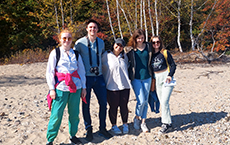
Environmental reporting students on the beach at Lakeport State Park
Students in Knight Center director Eric Freedman’s Environmental Reporting class spent a day in Port Huron, Michigan, to explore transborder U.S.-Canadian environmental problems, including the continuing cleanup of a toxic hot spot and the threat of invasive species.
Such problems – along with extreme weather events, air and water pollution, climate warming, wildfires and the like – pay no attention to national borders or political jurisdictions.
The St. Clair River separates Port Huron from Sarnia, Ontario. Both cities are on Lake Huron.

Learning about native plants along the Blue Water River Walk
The recent field visit, supported by a grant from MSU’s Canadian Studies Center, began with a 1-mile hike along the Blue Water River Walk led by Shari Faust and Lynnea McFadden of the Friends of the St. Clair River.
Running for about 40 miles, the river connects Lake Huron with Lake St. Clair.
The U.S. and Canada jointly designated it as an Area of Concern because of contamination from heavy metals, toxic organic, and E. coli bacteria that sparked fish consumption advisories, beach closings and degraded habitat for native wildlife and fish, according to the Environmental Protection Agency.

Sarnia’s Chemical Valley across the St. Clair River from Port Huron’s Blue Water River Walk
Ambling along the river walk – a former railroad switch yard that is now a 10-foot-wide county park – we saw commercial ships plying the St. Clair’s waters, as well as the sprawl of refineries and other industrial operations on the Ontario shore in an area known as Sarnia’s Chemical Valley.
The river walk goes through a partially restored coastal wetland and includes sculptures, a fishing pier, an early 20th century railroad ferry dock, interpretive signs and native plants – plus some invasive plants that members of the Friends group volunteer to pull out.
Armor stone reefs and spawning beds have been placed in the river to create fish habitat.
From there, the group drove to the 565-acre Lakeport State Park on the Lake Huron shore. It was past prime park season, so there were few campers in view.
Sitting in the shade at a picnic table, the students talked with Christina Haska Baugher, an aquatic invasive species biologist at the Department of Natural Resources, who described the damage done to the Great Lakes by invaders and the difficulties in trying to control them.
The final stop was at Anderson’s Pro Bait where owner Joel Anderson discussed changes in Lake Huron fishing activities.
